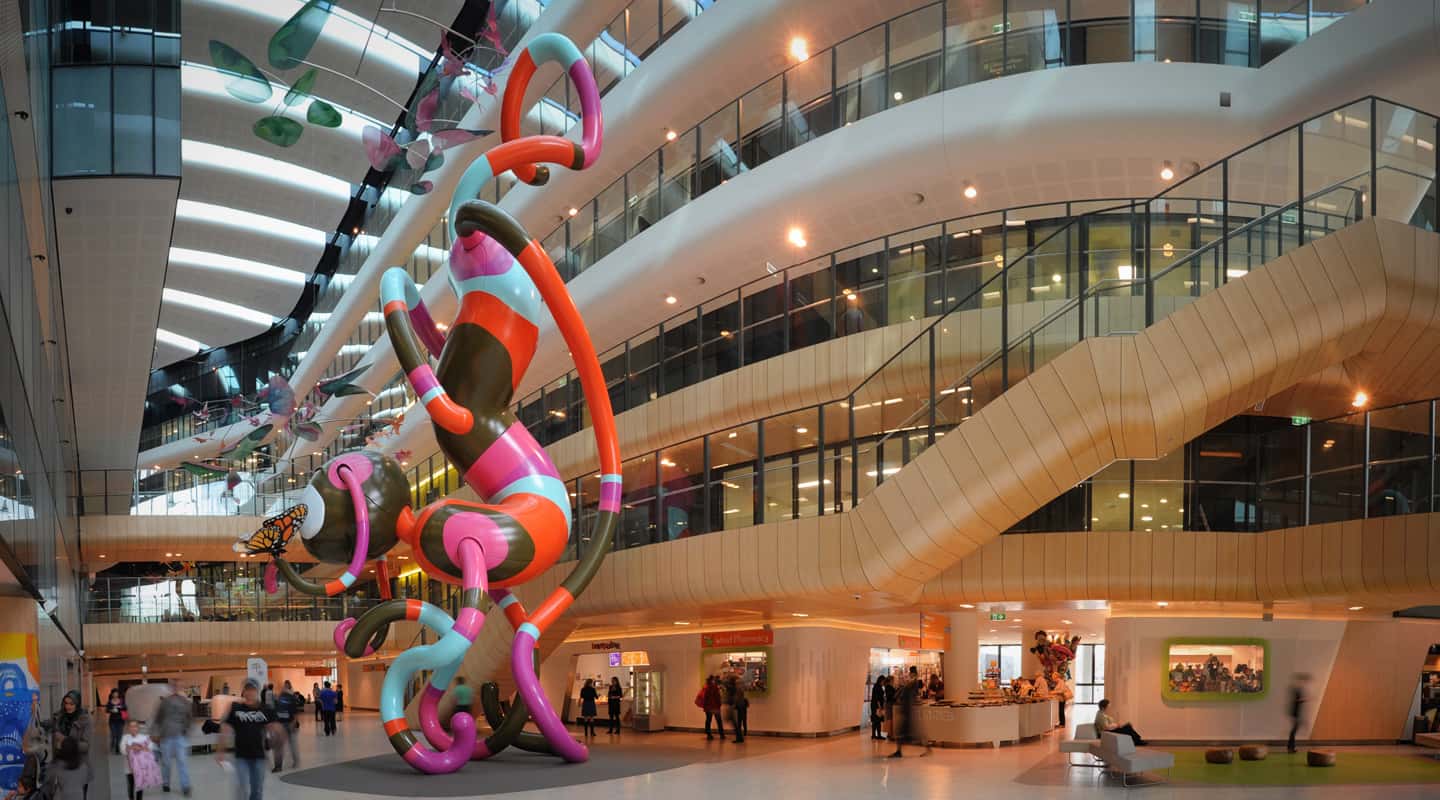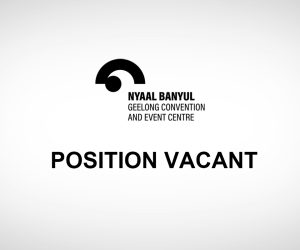
Healthy Alternative
The new Royal Children’s Hospital feels much better.

Text:/ Christopher Holder
Without wanting to be rude, I’d be quite happy never to set foot in the Royal Children’s Hospital. A visit inevitably means some kind of health concern for a child that matters to you and it’s really the last place you’d like to be.
Prior to a professional visit I had discussed the Royal Children’s Hospital (RCH) with a couple of friends and colleagues who unfortunately had cause to spend time there. And, despite the anxiety, they were highly complimentary. I kept hearing about the huge fish tank and the meerkats. Excuse me? Meerkats?! Yes, there’s a meerkat enclosure, and if any creature can help you forget your woes it has to be these little guys – you could watch them for days.
This, of course, is an AV story and although the meerkats are high-maintenance, they’re far from high-tech. But their presence does provide a yardstick for what motivated the building of this enormous hospital project. The designers were determined it would be an inspirational place for staff, patients and families. Bright, connected, funky and fun, the environment would be conducive to the highest standards of professionalism and the business of getting well.
RIDING INTO THE SUNSET
The new Royal Children’s Hospital initial AV design was released in 2006 as an analogue system. By 2010 the originally-contracted AV integrator (TCP) went under and a new integrator was sought to provide a digital solution to the existing designs.
In the third quarter of 2010 IBSAV (who has since changed its name to Pro AV Solutions) was awarded the project to deliver integrated digital AV technologies into more than 200 of the RCH’s 2000 spaces including operating theatres, learning spaces, auditoriums, laboratories, gardens, presentation areas, the Starlight Express entertainment areas and that two-storey aquarium.
When it comes to digital AV switching and transmission technology, it’s certainly one of the largest projects of its kind in Australia, bringing to life active learning environments for research and facilitating teaching between key education and research partners – the University of Melbourne (UoM) and Murdoch Children’s Research Institute (MCRI).
Glenn Yole, Pro AV Solution’s business development manager: “The digital video switching and distribution was probably the biggest challenge we had on this job. We won this project smack bang in the middle of the analogue sunset – not simply a challenge for us, but one of the greatest challenges seen by the whole industry!”
Everyone on the project was aware that digital technologies were going to provide the best (and much needed) quality for medical imaging. But digital infrastructure was limited to what was available or about to be released. Hybrid systems of both analogue and digital were not available and DVI-D was the only proven commercial solution. Pro AV Solutions spent six months testing various technologies to determine what would function together and what was reliable. At the time, remember, HDMI was still seen as a lounge room technology and large DVI infrastructure devices were still on the drawing boards of many manufacturers.
“”
every meeting room, operating theatre, educational space or auditorium is totally independent


Forget medecine – the major points of patient and visitor interest in the new building are the multistory fish tank and the Meerkat habitat
VC ON CALL
One very interesting aspect of this job is the lack of a conventional AV ‘network’. Every meeting room, operating theatre, educational space or auditorium is totally independent – every room has its own individual audiovisual identity. Each has a local AV rack; there’s no floor sharing. Linking the rooms is a video conferencing (VC) codec (a Tandberg/Cisco backbone via cat6) that brings the systems together and works in conjunction with RCH’s IT network.
Like many other hospitals, the RCH previously had VC ‘crash carts’ that would be wheeled in and out as required. Clearly this was less than ideal and the results unreliable at best. Now, with the investment in the Tandberg/Cisco C40 VC codecs and content server, any session or procedure in any of the dozens of rooms equipped with screens and Sony remote pan/tilt/zoom (PTZ) cameras can conference with any other similarly equipped space in the building. Glenn Yole cites the example of other hospitals trying to make do with desktop VC solutions such as Skype and GoToMeeting, and wondering why the experience is so underwhelming for critical telemedicine consultations. The answer of course lies in the quality of the VC infrastructure.

Each of the operating theatres has video conferencing capabilities — two with permanent VC codecs built in. Each has cameras, preview monitors and room control, and inputs (with scalers) for the older analogue devices that proved too expensive to upgrade (the machine that goes ‘ping’, for example). Each room has its own AV rack. Each is its own closed system, running with an emergency power backup. Revolabs lapel mics ensure the surgeons’ swearing is captured, while ceiling mics capture ambience. Each pendant arm packs S-Video, RGBHV and DVI I/O along with all the usual medical services like oxygen, suction, etc.
BACK TO SCHOOL
RCH is a training hospital with the aforementioned MCRI and UoM maintaining an ongoing presence in the building — moulding the doctors, nurses, and allied health professionals of tomorrow.
A big part of medical training is observing how the pros do it. Anyone who’s been in a hospital bed will be familiar with the scene of a consultant doing the rounds with a huddle of med students trailing behind. As you can imagine, this is less than desirable in the area of paediatrics. One strange bloke in a lab coat is normally enough to freak a child out, let alone another three bumbling students. Again, thanks to the Cisco VC back-end, there’s plenty that goes on within RCH that is now simulcast on- or off-site and indeed, recorded for ‘coaching and training’ purposes, to coin a phrase.
“The allied health department does a lot of undergraduate education,” RCH’s Tracey Lawson explained. “It’s very big on telemedicine, where they will record therapy sessions then present them to students. It’s better for the patient’s privacy – once permission is gained to record the session, the child’s not intimidated by having a room full of students and it doesn’t impact the quality of the session. A lot of the learning prior to this was impacted — there’s nothing ‘normal’ about a crowd of people.”
The other example cited by the hospital is the famous case of the Trishna and Krishna conjoined twins. With two kids in the operating theatre and effectively double the staff, space for two cameramen to capture the procedure was tight. Now with the new facility, Sony PTZ cameras taking care of video and Revolabs wireless mics capturing the sound, there’s a discreet hi-def solution on-call, so to speak.



CHILD’S PLAY
The Starlight Express room is a great example of good AV integration ‘making a difference’. The room is run by Hi-5-style ‘Captains’ (no names are intentionally provided), one of whom spoke to AV about what it is that the room does and how they use the AV.
“Starlight Express is a place in the hospital that’s not part of the hospital. When kids come in here they’re not sick kids, they’re just kids, and they’re all treated the same. In fact, if doctors or nurses come in here they’re not allowed to talk medicine, they have to play games like everyone else – and they do come in.”
There’s a variety of LCD panels for playing videogames, a Mitsubishi HD projector for movies (occupying one of four audio zones with a BSS BLU Soundweb making that possible), and a number of iMacs for more games and multimedia production for the older kids. But there’s more to the install than shaking your tush in Just Dance or blowing up aliens.
“We do two live TV shows every day, which means we’re creating a lot of content. Much of it is grabbing kids, telling them we’re doing a TV show and getting creative ideas from the kids themselves – ‘we should all be pink whales hosting the Oscars today’ – okay, great! The show is narrowcast on a closed circuit TV channel that can be viewed in any of the wards in the hospital. The telecast is put together live and combines prepackaged material along with the live work with the kids.”
Sony BCR300 PTZ cameras mounted in the ceiling of the room take care of most of the work. They’re especially useful in situations where there is only one Captain – preset camera positions and a presenter with an AMX touch panel means the show can go on without assistance. Revolabs wireless mics capture the sound, while a Panasonic vision mixer is used to switch the program.
“This setup is so much simpler and more reliable than what we had in the old place,” our Captain guide said. “Previously, we had a huge audio mixer and if we weren’t getting a sound for whatever reason, troubleshooting was a nightmare. Now with some basic training we’re across all the fundamentals and we’re adding to our knowledge all the time.
“We love the Revolabs mics. We used to run our wireless mics off AA batteries, but now we have the Revolabs which are charged in the docking station – they’re not just laying around and they’re always charged. In the old hospital invariably someone would start talking and the audio would start cutting out and you’d have to scavenge batteries out of someone’s remote control.
“Starlight Express has its own channel in the hospital. When we’re not doing our live-to-air show we can play movies or music and the like. We can cue all that up from the AMX controller. It’s easy for us to override the audio and do an announcement on our channel, letting the kids know something is happening in the Starlight Express room in 15 minutes, for example, or ‘call us if you’d like to request the next movie’. So we’ll get a kid ringing the Starlight Express number on the hospital phone system who might not be able to get down here and say, ‘I’d really like to see Hercules’. The channel allows us to interact with more kids.”
GEAR HIGHLIGHTS
106 × AV racks
151 × AMX control touchscreens, wireless touchscreens and controllers
130+ × LCD displays and projectors with recessed motorised screens
18 × 16×16 digital matrix switchers
400+ digital transmitter and receivers
MORE INFORMATION
Pro AV Solutions: 1800 006 514 or www.proavsolutions.com.au















RESPONSES